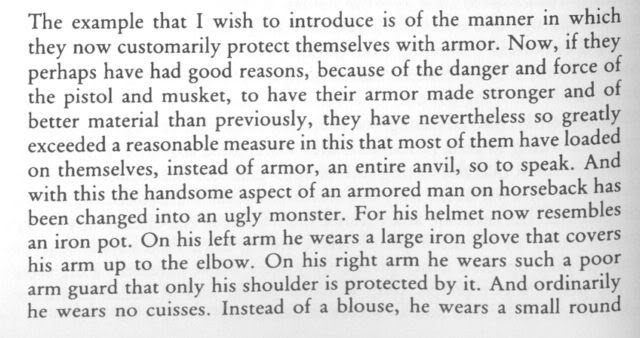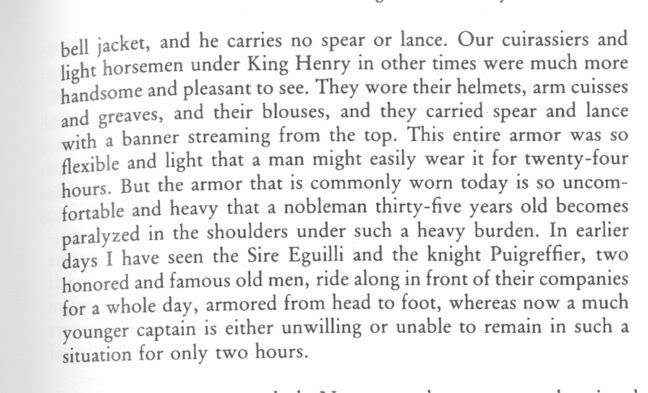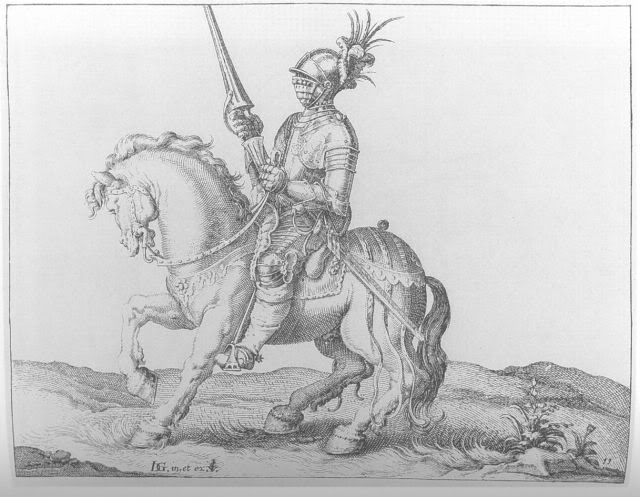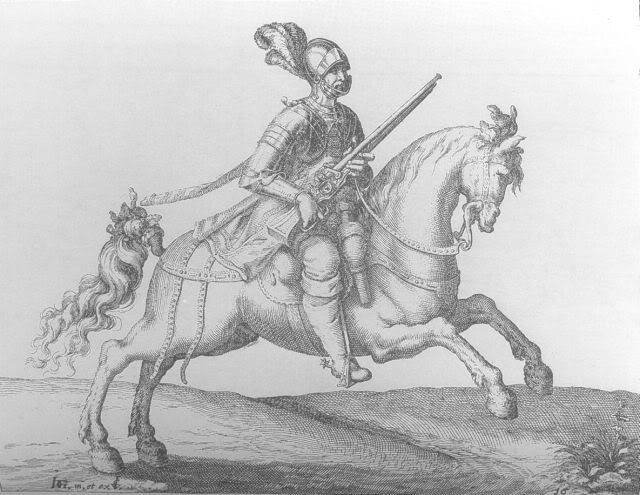| Author |
Message |
|
Paul Caspall
Location: Australia Joined: 06 Feb 2008
Posts: 8
|
 Posted: Fri 07 Mar, 2008 5:57 pm Post subject: Huguenot Cuirassier Armour Posted: Fri 07 Mar, 2008 5:57 pm Post subject: Huguenot Cuirassier Armour |
 |
|
Hi
This is my first post, so hello! 
I'm trying to find out what the Huguenot cuirassiers (specifically from 1580s) would have looked like. So far it seems they wore 3/4 armour (possibly with a few still wearing casaques over the top, hence them being called 'Millers'), and a range of mostly open-face helms (burgonets, morions), possibly with a few close-faced helms or earlier armets.
Can anyone point to some useful information, pictures on this subject?
Cheers
Paul
To come at this question from another angle...
If it can be said that the answer is along the lines of "they wore pretty much exactly what everyone else was wearing in Europe at that time", then:
Could someone point me to examples of helmets/armour worn during that period? For instance, most of the Renaissance period close-faced helms I've seen in the galleries on this site are 17thC (TYW), yet a couple claim to be 16thC. Maximilian style armets would be unlikely to have been worn in the 1580s. The Savoyard close-face helms are all 17thC from what I can gather. Most of the German close-faced helms of the TYW don't seem to have many (if any) predecessors getting around in the 1580s, etc., etc.
Any suggestions or links to examples would be appreciated.
|
|
  |
 |
Scott Eschenbrenner

|
 Posted: Fri 07 Mar, 2008 9:12 pm Post subject: Posted: Fri 07 Mar, 2008 9:12 pm Post subject: |
 |
|
Good question. I don't know either, but I did happen to know of some other pieces that might help. I don't think these are in the Features section of the site, but I apologize if I'm repeating information:
Robert Dudley's harness at the Royal Armouries, 1575 http://www.royalarmouries.org/extsite/view.jsp?sectionId=2851
A burgonet with falling buffe at the Met (NYC), 1555 http://www.metmuseum.org/Works_of_Art/collect...1&vT=1
Other than that, I think there's plenty of stuff from the Greenwich shop that was made during the period you're looking at. Is it plausible that Huguenot cavalry would have worn a similar style?
|
|
  |
 |
|
Paul Caspall
Location: Australia Joined: 06 Feb 2008
Posts: 8
|
 Posted: Fri 07 Mar, 2008 9:23 pm Post subject: Posted: Fri 07 Mar, 2008 9:23 pm Post subject: |
 |
|
Thanks Scott.
Dudley's armour looks too old and inapt for 1580's cuirassiers. More of a throwback party costume to entertain the Queen I suspect! 
The burgonet with falling buffe is useful - haven't seen that one before.
Will check out the Greenwich stuff.
Oh and I've found a good answer to my own question on this very site!
http://www.myArmoury.com/feature_spot_burgonet.php
Cheers!
Here's a nice example of parade armour 1560. Burgonet with bevor.

|
|
  |
 |
Florian H.

|
 Posted: Sat 08 Mar, 2008 3:08 am Post subject: Posted: Sat 08 Mar, 2008 3:08 am Post subject: |
 |
|
|
This particular armour, shown here, was made by Michael Witz, 1550 in Innsbruck, Tyrol. It now resides in the "Landeszeughaus" here in Graz. It was inspired by contemporary upper italian armour. Unfortunately I don't know for whom this piece was made. I could provide some photos, since I plan on visiting the Zeughaus tomorrow.
|
|
  |
 |
|
Johan S. Moen
Location: Kristiansand, Norway Joined: 26 Jan 2004
Posts: 259
|
 Posted: Sat 08 Mar, 2008 3:20 am Post subject: Posted: Sat 08 Mar, 2008 3:20 am Post subject: |
 |
|
| Florian H. wrote: | | Unfortunately I don't know for whom this piece was made |
According to my notes and catalogues, there is no information as to whom the armour was made for, except that he was a "nobleman".
Johan Schubert Moen
|
|
  |
 |
Scott Eschenbrenner

|
 Posted: Sat 08 Mar, 2008 3:42 pm Post subject: Posted: Sat 08 Mar, 2008 3:42 pm Post subject: |
 |
|
| Paul Caspall wrote: | Thanks Scott.
Dudley's armour looks too old and inapt for 1580's cuirassiers. More of a throwback party costume to entertain the Queen I suspect! 
|
Maybe, but Dudley did participate in military campaigns on the Continent so it's possible that he wanted the armour to be functional. Of course, he wasn't a very good soldier, but I'm sure he would have had at least some idea of what constituted good field armour. Perhaps that piece is too ornate.
What about it looks out of date or impractical to you, aside from the decoration? There's no question that the peascod breastplate and the shape of the tassets imitate civilian fashion, but it still appears functional.
That's a great illustration of 3/4 armour, by the way. I think leaving off the decoration but keeping the form would probably give a fair idea of field armour for the period.
Here's another one from the Met. It's royal, so it has much more decoration than might have been usual, and it's from 1555, but if you remove the greaves, the piece has nearly the same overall form and coverage as a later 3/4 harness. In other words, the arms and cuirass didn't change too much over the next few decades, and the upper leg protection could either be seen as tassets extended to the knees or fully articulated cuisses attached directly to the bottom of the cuirass. That trend seemed to continue into the 17th century.
http://www.metmuseum.org/Works_of_Art/collect...1&vT=1
|
|
  |
 |
|
Paul Caspall
Location: Australia Joined: 06 Feb 2008
Posts: 8
|
 Posted: Sat 08 Mar, 2008 8:22 pm Post subject: Posted: Sat 08 Mar, 2008 8:22 pm Post subject: |
 |
|
| Scott Eschenbrenner wrote: | | What about it looks out of date or impractical to you, aside from the decoration? |
It has more the look of Henry VIII period field armour, when Knights reached their autumn. In Henri of Navarre's mobile Huguenot army of the 1580's such automaton-like pieces were obsolete. And they'd be pretty rare (virtually unseen) in an Elizabethan army of that time as well.
Cheers
Paul
|
|
  |
 |
Gordon Frye

|
 Posted: Sat 08 Mar, 2008 8:47 pm Post subject: Posted: Sat 08 Mar, 2008 8:47 pm Post subject: |
 |
|
Paul;
This is a subject very close to my heart, and one which I've been studying for some years. To my mind, the Huguenots were the leaders in the move away from the old heavily armoured feudal cavalry towards the more lightly armoured, firearm-equipped cavalry of the 17th Century and later. Huguenot captains such as Francois de la Noue were military theorists of no mean rank, and their writings were closely followed throughout Europe. In fact the King of Sweden sent his eldest (natural) son to learn the Art of War from Henri of Navarre, and brought back his newfound knowledge to pass on to his younger brother, Gustavus II Adolphus.
The early years of the Wars of Religion found the Huguenots armed and equipped much like their Catholic/Royalist counterparts, in full armour cap-á-píe, and wearing their white cassocks over the armour as you've already noted above. In fact, there were several Royal compangnies d'ordonnance which went over en-masse to the rebellious Protestants, forming the core of their Cavalry arm. And indeed the early battles were fought with identical tactics, the Heavy Horse charging in en haye with lances lowered. However, at some point in the later-1560's, the idea of using Heavy Horse in columns, rather than in line was experimented with. Probably from their association with the Protestant German Schwartzreiters (who were of course pistol-armed Heavy Cavalry), they made a good impression against the Royalists even when loosing battles.
Aside from the possibility of simply believing that the column was a much stronger formation (and that the use of the linear formation was primarily due to the desires of nobles who refused to be behind men they considered their social equals or inferiors), it is entirely posssible that the Huguenots adopted the column due to poverty. They could place their less well armed and horsed men in the rear ranks where they would still add cohesion to the column, but not be the liability that they would be in the front ranks. There is a great quote which deals with this very issue:
There are 18 cornets supposed to consist of 80 troopers apiece. In mine there were 75: some are much larger; but the one supporting mine had only 40 or 45. The ranks behind the flag of this unit are filled up with men who have only buff coats and pistols: of gentlemen wearing cuirasses and closed helms, and with horses worth 50 gold crowns, there are, except in the very largest cornets, not more than ten or a dozen. These are called the 'gens de combat', and these decide the day
Even Rosny (later the Duc de Sully) records that on occasion all he had to wear was a rusty corselet and helmet, without arm defenses of any kind. So while the top of the Huguenot leadership was arrayed in excellent armour (Henri of Navarre certainly was), many of his men, even those considered to be hommes d'armes were accoutred to somewhat lower standards. But of course the aspiration was for a good 3/4 suit, or even full armour, even if it wasn't often reached in practice.
(BTW, check out the article here on myArmoury: http://www.myArmoury.com/feature_lancepistol.html A little self-promotion on my part, but I think you will discover the information to be of value.)
Cheers!
Gordon[/quote]
"After God, we owe our victory to our Horses"
Gonsalo Jimenez de Quesada
http://www.renaissancesoldier.com/
http://historypundit.blogspot.com/
|
|
    |
 |
|
Paul Caspall
Location: Australia Joined: 06 Feb 2008
Posts: 8
|
 Posted: Sat 08 Mar, 2008 9:45 pm Post subject: Posted: Sat 08 Mar, 2008 9:45 pm Post subject: |
 |
|
Thanks Gordon.
That article was one of the first I saved. 
I imagine you already possess this article on Henri Navarre's army:
"All the King's Horsemen": The Equestrian Army of Henri IV, 1585-1598
Ronald S. Love
Sixteenth Century Journal, Vol. 22, No. 3 (Autumn, 1991), pp. 510-533
doi:10.2307/2541473
This article consists of 24 page(s).
I still have to get it. 
The poverty issue you mention is new to me. I'm intending to build a wargames army in either 15mm or 28mm, so a mix of armour sounds apt based on your comments and that quote.
Do you believe that by the 1580s the cassock over the armour would be unused? Or just limited to a few diehards or leaders?
Thanks very much for your insight.
Cheers
Paul
|
|
  |
 |
Scott Eschenbrenner

|
 Posted: Mon 10 Mar, 2008 3:10 pm Post subject: Posted: Mon 10 Mar, 2008 3:10 pm Post subject: |
 |
|
| Paul Caspall wrote: |
It has more the look of Henry VIII period field armour, when Knights reached their autumn. In Henri of Navarre's mobile Huguenot army of the 1580's such automaton-like pieces were obsolete. And they'd be pretty rare (virtually unseen) in an Elizabethan army of that time as well.
|
Okay, I thought you meant a particular technical aspect. Certainly full armour was less useful in combat by this period. I do think the style is still fairly representative (the way the arms are constructed and articulated, for example) of armour that you might have seen in the field, perhaps in the form of half or 3/4 harnesses.
Found a more utilitarian-looking 3/4 piece on Wikipedia. It's described as a heavy cuirassier harness, 16th century. Looks like the breastplate has been "proofed." The arms have the same basic style as the Greenwich armours (I think they all basically do by now):
http://upload.wikimedia.org/wikipedia/commons...l_body.jpg
Thanks for the post, Gordon. What's your opinion on the style of cavalry armour from this period? Do the extant museum pieces give us an accurate overall impression, taking into account what you said about cost?
|
|
  |
 |
|
Allan Senefelder
Industry Professional
|
 Posted: Mon 10 Mar, 2008 4:08 pm Post subject: Posted: Mon 10 Mar, 2008 4:08 pm Post subject: |
 |
|
|
Robert Dudley's armour was from the apogy of the quality production of the Greenwich armouries and of the most current style in terms of the plate shape and layout when made c.1570's. While full harness was in decline, it was far from done, fully harnesses curassiers were used in the opening years of The Thirty Years War. Additionally commissioning harness of this quality was still an expression of wealth and prestige at the time of Robert's harness being made. The large mainfer gauntlet on the left hand indicates that this particular armour was probably intended for use in tournament, also indicated by the note in the captioning of the picture linked above, that it was used in several entertainments hosted by Robert for the queen in 1575.
|
|
   |
 |
Daniel Staberg

|
 Posted: Tue 11 Mar, 2008 5:44 pm Post subject: Posted: Tue 11 Mar, 2008 5:44 pm Post subject: |
 |
|
This is how La Noue describes the armour of the Huguenots.


From Delbrück's "The Dawn of Modern Warfare" so it has been translated from French to German and then from German to English.
Do note that the "King Henry" mentioned in the text is Henri II, not Henri IV.
Dillich's Kriegsbuch from 1606 shows an armour similar to that described by La Noue but in a distictly 'German' style evolved from the armour used by the Reiters. (Of course 'German' style armour was exported and used by non-German troops) The main difference is that the burgonet which was common for in the 1550-1600 period has been replaced by a "Hungarian Pot" (aka Zischägge) as a resutl of the experiences during the so called "Long war" wit the Ottoman Empire from 1593 to 1606.

The following 3 plates are among the images commisioned for the 1596 dutch cavalry manual which was never published. They give a good view of well equipped cavalry using non-German armour.
Cuirassier

Lancer

Harquebusier

The casaque or cassock was worn by most cavalry which could aford it in this period be they French, Dutch, Spanish or English. Only among the German was it uncommon but still worn by some units.
|
|
  |
 |
|
Paul Caspall
Location: Australia Joined: 06 Feb 2008
Posts: 8
|
 Posted: Wed 12 Mar, 2008 4:56 pm Post subject: Posted: Wed 12 Mar, 2008 4:56 pm Post subject: |
 |
|
Great inclusions there Daniel. Thanks!
I see that particular form of strapped horse tack seems to be dominating this era right up to the close of the century too.
Re: the casaque still being worn on a regular basis in the 1580s, I still have some doubts. But that transcript of La Noue's has me intrigued. When was it written?
Any idea what the "small round bell jacket" appears like, as opposed to the "blouses" referred to?
Thanks again, and I've saved your attachments.
Cheers
Paul
|
|
  |
 |
Daniel Staberg

|
 Posted: Wed 12 Mar, 2008 5:47 pm Post subject: Posted: Wed 12 Mar, 2008 5:47 pm Post subject: |
 |
|
|
La Noue's Discours politiques et militaires was written during his captivity 1580-1585 and then published in 1587. There is ample evidence, both written and pictorial that cassocks were still worn with the armour until the very end of the 16th century. However impoverished armies like the Huguenots forces of the pre-1588 period would have had to make do with a less flamboyant verions i.e the jacket mentioned by La Noue. Or not worn one at all but then the gentleman in question would probably be without armour as well.
|
|
  |
 |
|
Allan Senefelder
Industry Professional
|
 Posted: Wed 12 Mar, 2008 6:37 pm Post subject: Posted: Wed 12 Mar, 2008 6:37 pm Post subject: |
 |
|
| Quote: | | Re: the casaque still being worn on a regular basis in the 1580s, I still have some doubts |
Armour is expensive and a commodity, it was not thrown on the scrap heap because other fashions has superceded it. When Rhodes fell to the turk in 1522, breast and back plates and armets from the 1430's were still in the armoury of the fortress in service. There are hundereds of casquetelles in Graz commisioned for the armoury at the end of the 16th century. Floating around here in the forums is a thread where a fella posted his very English very 17th century casquetelle that he had recently aquired.
|
|
   |
 |
|
Paul Caspall
Location: Australia Joined: 06 Feb 2008
Posts: 8
|
 Posted: Wed 12 Mar, 2008 6:51 pm Post subject: Posted: Wed 12 Mar, 2008 6:51 pm Post subject: |
 |
|
Okay, I'm convinced. 
I'm curious about this 'jacket' though.
I wonder if this 15mm Essex miniature of a Huguenot "Miller" has it sort of right:

. . . as opposed to these 25mm ones by Old Glory, that resembles a tabard:

|
|
  |
 |
|
Paul Caspall
Location: Australia Joined: 06 Feb 2008
Posts: 8
|
 Posted: Tue 25 Mar, 2008 11:57 pm Post subject: Posted: Tue 25 Mar, 2008 11:57 pm Post subject: |
 |
|
Little bit of thread necromancy here, but the Old Glory picture wasn't functioning for some time - a problem with their site. Which leaves the last post's question unanswered.
I'm posting the Old Glory Millers pic again, but from a different source.

|
|
  |
 |
|
Helge B.
|
 Posted: Thu 27 Mar, 2008 12:54 am Post subject: Posted: Thu 27 Mar, 2008 12:54 am Post subject: |
 |
|
| Quote: | | Dillich's Kriegsbuch from 1606 shows an armour similar to that described by La Noue but in a distictly 'German' style evolved from the armour used by the Reiters. (Of course 'German' style armour was exported and used by non-German troops) The main difference is that the burgonet which was common for in the 1550-1600 period has been replaced by a "Hungarian Pot" (aka Zischägge) as a resutl of the experiences during the so called "Long war" wit the Ottoman Empire from 1593 to 1606. |
What's this thing shown in fig. 21? Ist this some kind of magzine holding preloaded charges und balls?
|
|
  |
 |
|
Lafayette C Curtis
|
 Posted: Thu 27 Mar, 2008 11:43 pm Post subject: Posted: Thu 27 Mar, 2008 11:43 pm Post subject: |
 |
|
| Daniel Staberg wrote: | | The casaque or cassock was worn by most cavalry which could aford it in this period be they French, Dutch, Spanish or English. Only among the German was it uncommon but still worn by some units. |
While we're at it, I'm curious if there are any websites or books that provide details on how to construct these cavalry casaques. They look like they could be nice DIY additions to my collection...
|
|
  |
 |
Daniel Staberg

|
 Posted: Sat 26 Apr, 2008 10:03 am Post subject: Posted: Sat 26 Apr, 2008 10:03 am Post subject: |
 |
|
| Gordon Frye wrote: |
There are 18 cornets supposed to consist of 80 troopers apiece. In mine there were 75: some are much larger; but the one supporting mine had only 40 or 45. The ranks behind the flag of this unit are filled up with men who have only buff coats and pistols: of gentlemen wearing cuirasses and closed helms, and with horses worth 50 gold crowns, there are, except in the very largest cornets, not more than ten or a dozen. These are called the 'gens de combat', and these decide the day
|
Gordon et al.
Every time I read that part of Omans work (Page 406 in the 1937 edition) I've been mystified by the "buff coats"since no one else seems to be using buff coats until some 40 years later. So I managed to track down a copy of d'Aubigne's "Histoire universelle" in the orignal French at the library today and with some work managed to find the orignal quote. The garment in the orignal French text is a 'casacque blanche', a white cassock (!) Either Oman made a serious error when he made the translation or he used a 17th Century English translation which contained the error.
So it seems like a not inconsiderable part of the Huguenot cavalry went into protected only by their faith(!)
Perhaps Admiral Coligny adopted deeper formations in 1570 (at Arnay-Le-duc) due to the need to provide his squadrons with at least one rank of "gens de combat"? The Huguenot nobility and gentry in arms which would have supplied most of those men had been depleted by the heavy losses at Jarnac and Montcontour.
Cheers
Daniel
|
|
  |
 |
|
|

